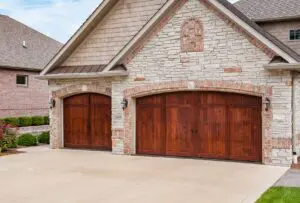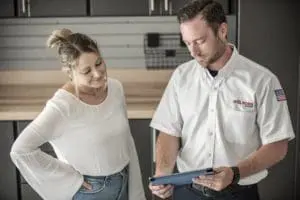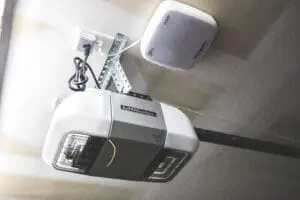
How Much Does Garage Door Repair Cost in 2025?
Tired of holding the garage door button just to get it to open or close? Learn the common causes, easy DIY fixes, and when to call Welborn Garage for expert help.
There’s nothing quite like the sinking feeling of hitting the garage door button—only to watch the door stop halfway or bounce right back open.
Not only is it frustrating, but it can leave your home and valuables vulnerable. If your garage door isn’t closing all the way, you’re not alone—and you’re definitely not powerless.
We’ve seen just about every reason a garage door refuses to shut. Some are simple fixes. Others may need a professional hand.
Either way, we’ll walk you through the most common causes, how to check for them, and when it’s time to call in the pros.
Let’s start with the most common reason we see garage doors that won’t close: the safety sensors. These little devices sit near the bottom of your garage door tracks, one on each side.
They’re designed to keep your family, pets, and stuff safe by preventing the door from closing on anything in its path.
What Can Go Wrong?
DIY Fix:
Still not closing? Try holding the wall button down. If the door closes that way, it’s definitely a sensor issue. If not, keep reading.
Sometimes, it’s not the door—it’s the thing you’re using to control it.
Check These:
DIY Fix:
Hold down the lock button for 3-5 seconds to disable it.
Your garage door travels on metal tracks when opening and closing. If anything’s off, it can stop the door from working right.
Signs to Look For:
DIY Fix:
If the tracks are damaged, it’s time to call a professional garage door technician (like us).
Torsion or extension springs are what make your heavy garage door feel light. When one breaks, the door might struggle to move—or won’t close at all.
Warning Signs:
DIY Fix:
None. Seriously—garage door springs are dangerous and under high tension. Leave this one to the pros.
Your garage door opener tells the door how far to travel using limit settings. If they’re off, your door might stop too soon or even reverse before touching the ground.
How It Happens:
DIY Fix:
Check your owner’s manual or the opener itself—most models have small dials or screws labeled “up” and “down” or “open” and “close.” Carefully adjust the “down” limit a little at a time and test.
Pro Tip: If your door closes all the way and then pops back open, your settings are likely telling it that it hit the ground too soon. Adjust until the door closes and stays closed.
It might seem obvious, but sometimes the problem is physical. Look closely at your garage door and the space around it.
What to Check:
DIY Fix:
Remove anything in the door’s way. If a panel or roller looks damaged, that’s a job for a garage door technician.
Here in Texas, we don’t deal with blizzards often—but cold snaps and moisture can still mess with your garage door.
Cold Weather Can Cause:
DIY Fix:
Let the garage warm up a bit if possible.
Just like your phone or router, sometimes your garage door opener needs a reset.
DIY Fix:
Try the door again.
If needed, reprogram your remotes using the “learn” button on the opener (usually near the light cover).
If your garage door is 15-20+ years old, the opener and parts may just be worn out. The sensors might fail often, the door might stick, or the whole system might act… a little quirky.
Signs It’s Time for an Upgrade:
Upgrading Your Door or Opener Can Mean:
If you’ve tried the simple stuff and your door still won’t close, don’t push your luck. Messing with springs, tracks, or wiring without experience can be dangerous—not to mention frustrating.
At Welborn Garage, we’ve been fixing garage doors across the Dallas-Fort Worth area for decades. Our expert techs show up on time, treat your home like it’s our own, and get the job done right—the first time.
We also offer same-day service for urgent repairs, so your door won’t stay stuck halfway when you’ve got places to be.

Don't let your garage project, just be a project. Schedule today, and make your garage the centerpiece of your home!

Tired of holding the garage door button just to get it to open or close? Learn the common causes, easy DIY fixes, and when to call Welborn Garage for expert help.

Tired of holding the garage door button just to get it to open or close? Learn the common causes, easy DIY fixes, and when to call Welborn Garage for expert help.

Tired of holding the garage door button just to get it to open or close? Learn the common causes, easy DIY fixes, and when to call Welborn Garage for expert help.